
Grading Our 2023 MRX Predictions
January 12, 2024
New Year, New Predictions for MRX: Our 2024 Predictions for the Industry
January 19, 2024As the new year begins, many people make New Year’s resolutions, and most deal with leading a healthier lifestyle. This could be eating better, working out more, losing weight, etc. Something that always comes up when you talk about this is the latest health and wellness trends. We wanted to understand this better, so in our latest round of research-on-research, we asked people about their awareness levels of some of the latest trends in health and wellness.
Here are some of the trends we asked about:
Drinking Greens involves consuming leafy greens in various forms, often as juices or smoothies, renowned for their high nutrient density.
Seamoss, a type of seaweed, has garnered attention for its rich mineral content and potential health benefits.
Oil Pulling, an ancient dental technique, involves swishing oil in the mouth to improve oral health.
Dry Brushing is a skin exfoliation method believed to stimulate the lymphatic system.
Cold Water Therapy encompasses practices like cold showers or swims, which are thought to improve circulation and boost immunity.
Sober-Curious Lifestyle represents a shift towards reducing alcohol intake to enhance mental clarity and overall well-being.
These trends reflect a facet of the growing movement towards natural and proactive health management. Let’s dive into what we uncovered!
Overall
Respondent’s awareness of these health and wellness trends is clearly stratified, with ‘Drinking Greens’ recognized by nearly half of the respondents, making it the most acknowledged trend we asked about.
Conversely, the concept of a ‘Sober-Curious Lifestyle’ is familiar to only 12% of participants, suggesting that this trend has not yet achieved widespread recognition. We found a 32% greater likelihood of respondents being aware of ‘Drinking Greens’ than ‘Sober-Curious Lifestyles’.
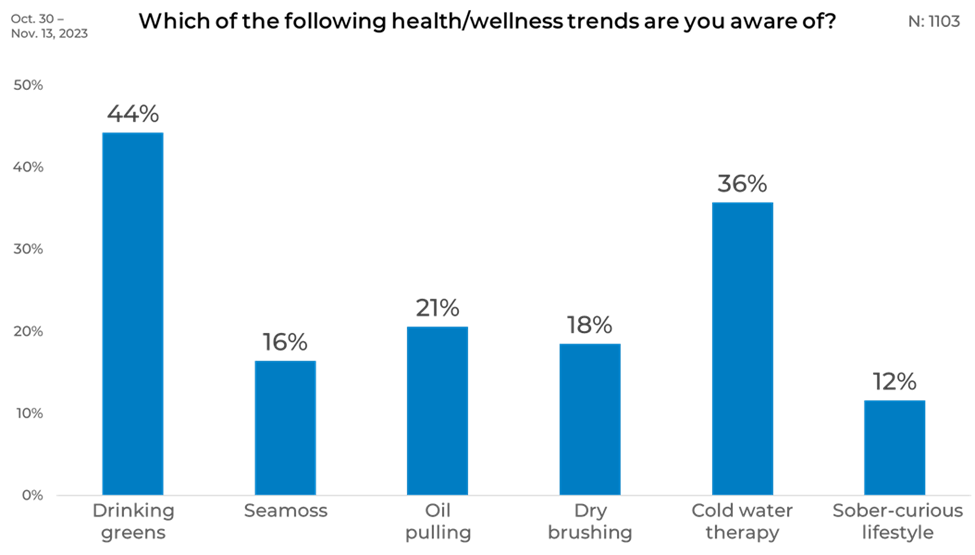
Gender
When breaking down the results by gender, we uncovered some nuances. Women have marked their territory as the more informed gender across nearly all the wellness trends we asked about. They shine particularly in their awareness of ‘Drinking Greens’ and ‘Oil Pulling,’ outpacing men by 8%. This statistic is more than a mere number; it reflects a broader awareness among women regarding these health practices. However, the waters of awareness shift when we look at ‘Cold Water Therapy,’ where men edge forward with a slightly higher awareness.
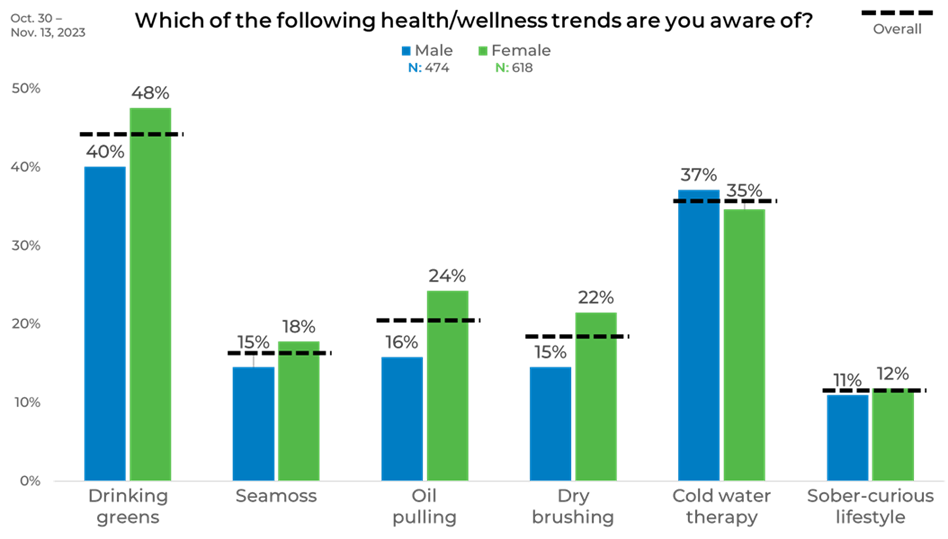
Age
We also found a clear age-related pattern in health and wellness trend awareness. Those aged 25-34 have the highest trend awareness, with an average percentage of 32%, and are the most informed about every trend listed. This group’s awareness peaks for each of the wellness practices surveyed, from ‘Drinking Greens’ to ‘Sober-Curious Lifestyles.’
One trend we uncovered was that as age increased, there was a decline in awareness, culminating in the 65+ demographic, with the lowest levels of awareness for all trends. Specifically, their awareness of ‘Seamoss’ is at 3%, starkly contrasting the younger cohorts. On average, those over 65 are 8% less aware of the health and wellness trends than their nearest age group, illustrating a significant generational gap in trend familiarity.

Income
Income levels appear to correlate with awareness of health and wellness trends, as illustrated by the survey data. Those earning below $20,000 annually show the lowest average awareness percentages, mainly ‘Drinking Greens,’ whose awareness is 13% lower than other income brackets.
Conversely, individuals with incomes between $40,000 and $59,999 demonstrate the highest average awareness. Respondents in this income bracket lead in familiarity with practices such as ‘Oil Pulling,’ ‘Dry Brushing,’ and ‘Cold Water Therapy.’
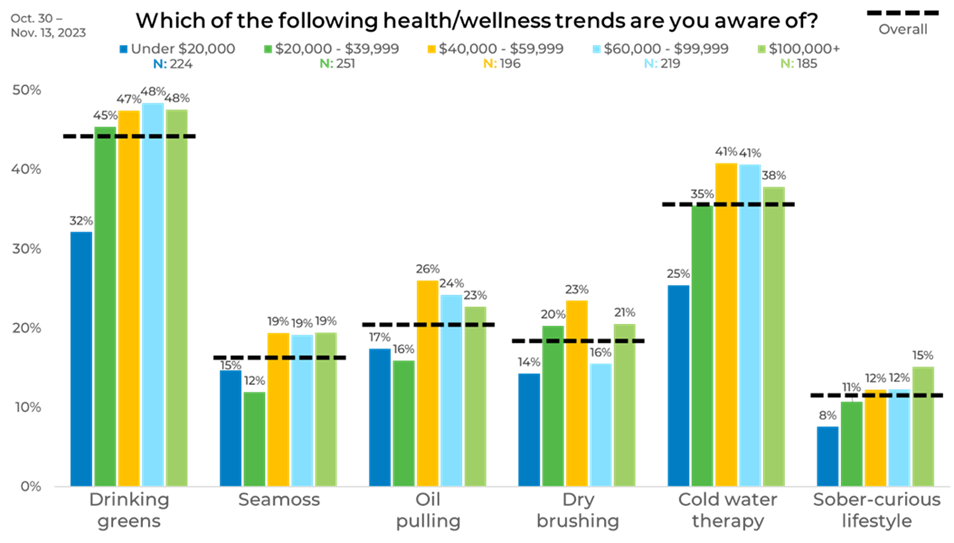
Political Affiliation
In what is increasingly rare in this political age, Republicans, Democrats, and Independents find common ground with their awareness of various health trends. Each group averages a 25% awareness rate across the six wellness trends presented, depicting a bipartisan consensus on recognizing these health practices.

Region
A look at health and wellness trend awareness regionally reveals that the Northeast is a beacon of knowledge, leading with the highest average percentages across the board. Notably, this region stands out for its awareness of ‘Drinking Greens,’ ‘Dry Brushing,’ ‘Cold Water Therapy,’ and ‘Sober-Curious Lifestyles,’ indicating a strong awareness of a variety of wellness practices.
In stark contrast, the Midwest shows a different landscape, recording the lowest average percentages in awareness. When it comes to ‘Drinking Greens,’ the Midwest is trailing 14% behind the Northeast. Moreover, this region is 9% less knowledgeable about ‘Sea Moss’ than its counterparts. Except for ‘Oil Pulling’ – where the South holds the least awareness – the Midwest consistently ranks as the least informed about these health and wellness trends.
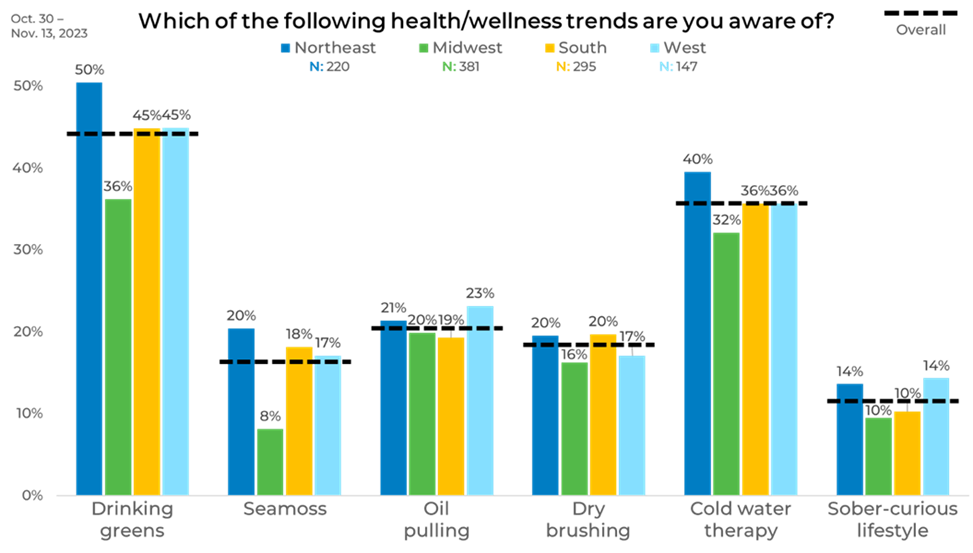
Ethnicity
Breaking down the results by ethnicity, Hispanic/Latino respondents have the highest awareness, with over half (54%) being aware of ‘Drinking Greens,’ which is 10% higher than any other ethnic group. They also lead in knowledge about ‘Cold Water Therapy,’ with 48% awareness—12% more than any other ethnicity.
A notable difference is observed with ‘Seamoss,’ where African-American or Black respondents have a 16% higher awareness than their Caucasian counterparts. Overall, Hispanics/Latinos display the highest average awareness across all health and wellness trends.
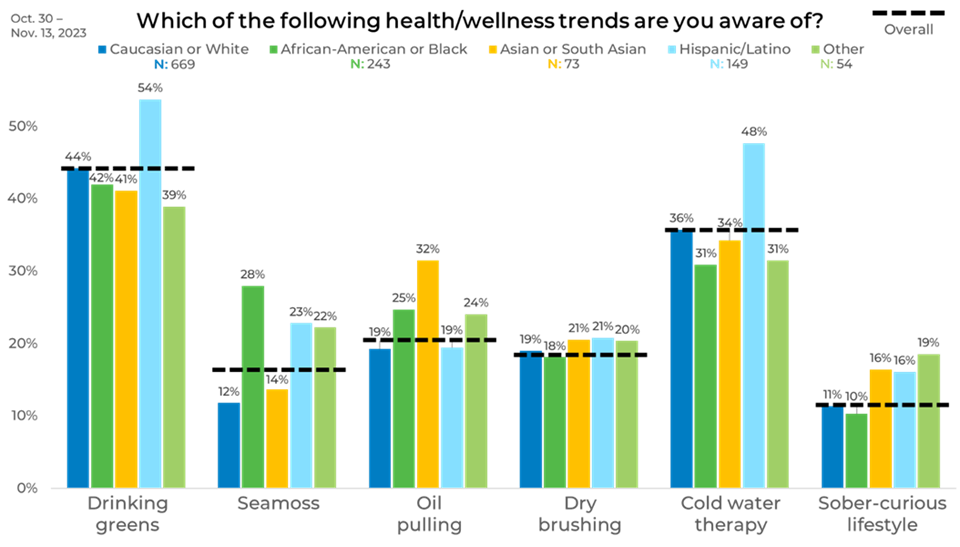
Panel
Analyzing the results by panel shows some striking disparities in the awareness of health and wellness trends. Panel E stands out, with a significant 20% greater likelihood of being aware of ‘Cold Water Therapy’ compared to Panel D. Furthermore, Panel E leads with a 16% higher awareness of ‘Drinking Greens’ than any other panel, marking them as exceptionally informed on these particular trends.
If we generalize the findings, selecting Panel E would equate to an average of 33% awareness across the health and wellness trends surveyed. In contrast, Panels A and D sit at the lower end of the spectrum, each averaging around 20% awareness. This notable gap highlights the variances in familiarity with health and wellness concepts across different panels.
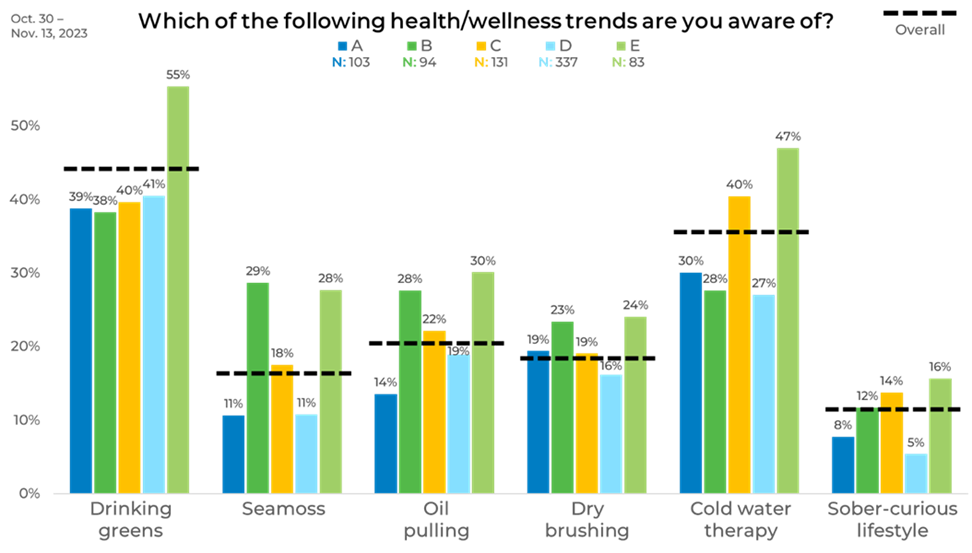
As you can see, awareness can vary significantly across demographics and by panel, which can impact your data. That is why strategically blending sample is the best practice to ensure you are accounting for distributed demographic, as well as attitudinal and behavioral balance.
Learn more about panel differences in our annual report on the sample industry, The Sample Landscape: 2023 Edition.




